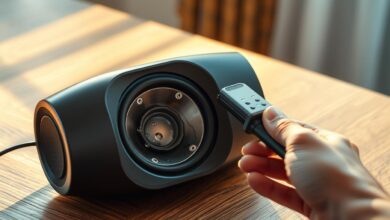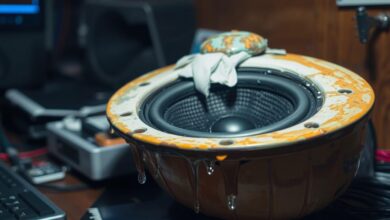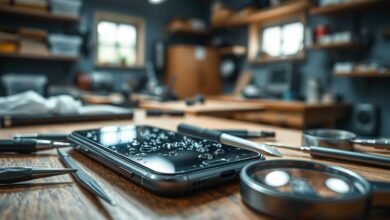how to get water out of iphone speaker
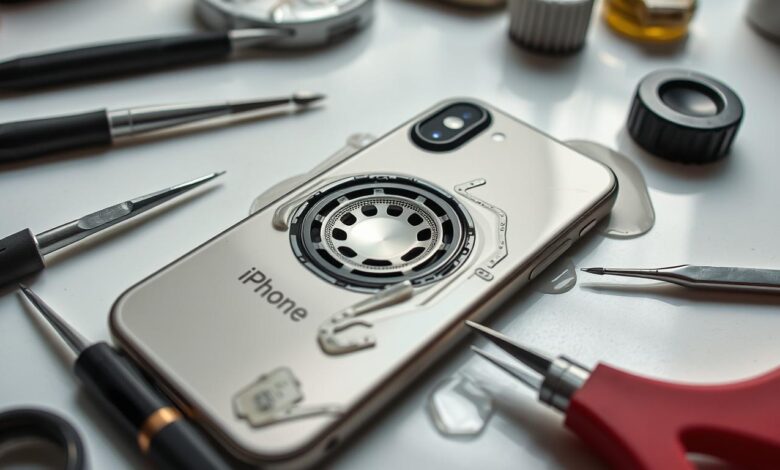
Water damage can be really frustrating, especially when it messes with your iPhone’s speaker. If you’ve accidentally gotten water on your device, you might wonder how to fix it. In this guide, I’ll show you how to safely get water out of your iPhone speaker.
Fixing water damage on an iPhone can be tricky, but it’s doable with the right steps. I’ll share different ways, from using sound waves to getting help from pros. This will help you choose the best option for your situation.
Key Takeaways
- Methods to remove water from iPhone speaker
- Precautions to prevent further damage
- Professional repair options for water damage
- Tips to restore iPhone functionality
- Understanding water damage repair process
Understanding Water Damage in iPhone Speakers
It’s important to know how water damage affects iPhone speakers. This knowledge helps in fixing and troubleshooting. Water can ruin your iPhone’s sound, making it distorted or not working at all.
How Water Affects Speaker Functionality
Water in the iPhone speaker can cause big problems. It can harm the diaphragm and coil inside. This damage might make the sound bad or stop it from working.
Water can also lead to corrosion on metal parts. This makes things worse.
Types of Water Damage
Water damage on iPhone speakers comes in two main types: corrosion and short circuits. Corrosion happens when water damages metal parts over time. Short circuits occur when water connects electrical parts, causing them to fail.
| Type of Damage | Description | Impact on Speaker |
|---|---|---|
| Corrosion | Reaction of water with metal components | Gradual degradation of speaker quality |
| Short Circuits | Water causing electrical components to malfunction | Immediate loss of speaker functionality |
Signs That Water Is Trapped in Your iPhone Speaker
Knowing the signs of water in your iPhone speaker is key to fixing it. Water can cause problems from minor distortions to full speaker failure.
Audio Distortion Symptoms
Audio distortion is a big sign of water in your iPhone speaker. You might hear muffled or fuzzy sound or crackling or popping noises. These sounds mean water is messing with your speaker.
Other signs include sound being much quieter or not coming out at all. If your iPhone sounds off after getting wet, water might be stuck in the speaker.
| Symptom | Description |
|---|---|
| Muffled Sound | Audio comes out fuzzy or unclear |
| Crackling or Popping Noises | Distortion due to water affecting speaker functionality |
| Reduced Volume | Significant decrease in sound output |
Visual Indicators of Water Presence
There are also visual signs of water in your iPhone speaker. Seeing water droplets in the speaker grill is a clear sign. If you spot water, it means moisture has gotten in.
Another sign is corrosion or mineral deposits around the speaker. When water dries, it leaves behind deposits that can harm the speaker over time.
| Visual Indicator | Description |
|---|---|
| Water Droplets | Visible water inside the speaker grill |
| Corrosion or Mineral Deposits | Residue left after water evaporates, potentially causing corrosion |
Quick Emergency Steps After Water Exposure
When your iPhone meets water, every second counts. Acting quickly can significantly reduce the risk of permanent damage to your device.
Immediate Actions to Take
The first step is to turn off your iPhone immediately to prevent any short circuits that could cause further damage. Next, remove any accessories such as cases or SIM cards to help your iPhone dry faster. Gently pat the exterior dry with a soft cloth, paying extra attention to the ports and openings.
If you’re near a sink or a safe water source, you can gently rinse the iPhone with fresh water. This is to remove any corrosive substances if it was exposed to saltwater or other liquids. However, avoid pressing any buttons or trying to charge your iPhone until you’re sure it’s dry.
What NOT to Do
Avoid charging your iPhone or trying to use it until it’s completely dry, as this can cause a short circuit. Don’t try to dry your iPhone using heat sources like a hairdryer or oven, as excessive heat can damage the internal components. Also, refrain from shaking or blowing into the ports, as this can push water further into your iPhone.
By following these immediate actions and avoiding common mistakes, you can improve the chances of fixing water damage on your iPhone and successfully completing a water damage repair.
Using Sound Frequencies to Remove Water
One effective way to dry your iPhone speaker is by using sound frequencies. This method uses sound vibrations to push water out of the speaker grills. The right frequency can remove water without harming your device.
How Sound Vibrations Expel Water
Sound vibrations create a disturbance in the water trapped in the speaker. When a specific frequency is played, it makes vibrations that push the water out. This gentle method is a good first step to dry your iPhone speaker.
Apps Designed for Water Ejection
Many apps help remove water from your iPhone speaker with sound frequencies. These apps create sound waves to push water out. Apps like Sound Frequency and Water Eject are available on the App Store.
Step-by-Step Guide to Using Water Eject Apps
To use a water ejection app, download and install it from the App Store. Open the app and follow the instructions to play the sound frequency. You’ll need to play the sound for a few minutes to remove the water. Check your speaker and repeat if needed.
By following these steps and using the right sound frequencies, you can dry out your iPhone speaker. This method, along with others, can get your device working again quickly.
The Rice Method: Does It Really Work?
I’ve seen the rice method suggested for fixing water-damaged iPhones. But does it actually work? The idea is that rice can soak up moisture from the device, possibly saving it. It’s key to know how this method works and how to use it right.
Science Behind the Rice Technique
The rice method uses uncooked rice’s ability to absorb moisture. This is why it’s sometimes used to dry wet items. For drying iPhone speakers, the goal is for the rice to pull out the water causing damage. But, not all rice is the same; only uncooked, dry rice works well for this.
Proper Implementation Steps
To use the rice method, first turn off your iPhone after it gets wet. Then, dry the outside with a soft cloth and take off any accessories. Next, put your iPhone in a container filled with uncooked rice, making sure it’s fully covered. Let it sit for at least 48 hours before trying to turn it on.
It’s also important to be patient and not charge or use your iPhone during this time. Doing so could cause more harm. By following these steps, you might be able to dry your iPhone’s speaker and fix iphone water damage solutions.
In conclusion, while the rice method isn’t perfect, it can be helpful when done right. By understanding the science and following the steps, you might save your device.
Using Silica Gel for Water Removal
Silica gel packets are great for soaking up moisture. They can help fix drying iphone speaker problems caused by water. You often find them in packaging for electronics and other items that don’t like water.
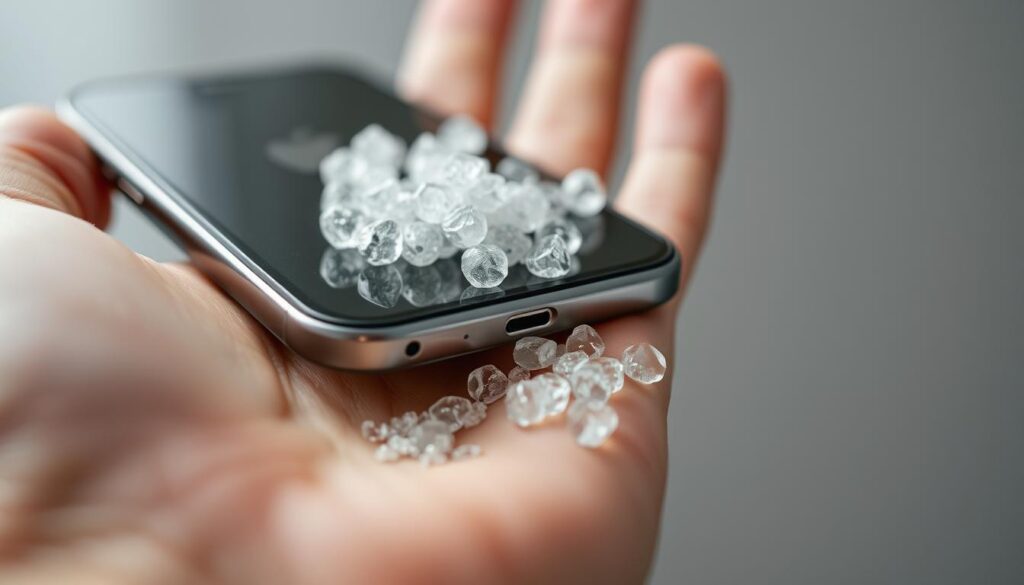
Why Silica Gel Is Effective
Silica gel works well because it’s very porous. It can soak up water in an iPhone speaker. This might fix iphone water damage solutions issues. For more tips on saving a wet phone, check out wikihow.
How to Use Silica Gel Packets Safely
To safely dry your iPhone speaker with silica gel packets, follow these steps:
- First, make sure your iPhone is off to avoid short circuits.
- Put your iPhone in a container or bag with silica gel packets. The number needed depends on your iPhone’s size and how wet it is.
- Close the container or bag to keep it dry.
- Leave your iPhone in the dry space with silica gel for 24 to 48 hours. This gives the silica gel enough time to soak up the moisture.
- After waiting, take out your iPhone and see if the speaker works.
Using silica gel packets is a simple way to try and dry out your iPhone speaker. But, how well it works depends on how much water damage there is.
How to Get Water Out of iPhone Speaker Using Gravity
Getting water out of your iPhone speaker is easy with gravity. Just place your iPhone right and tap it gently. This helps water droplets fall out of the speaker.
Positioning Your iPhone for Maximum Drainage
To use gravity, hold your iPhone so the speaker is down. This lets water droplets fall out. You can also tilt it to get water from different parts of the speaker.
Here’s a simple table to illustrate the recommended positions:
| Position | Description |
|---|---|
| Speaker Downwards | Hold iPhone with speaker facing downwards |
| Tilted Left/Right | Tilt iPhone to help dislodge water from speaker grilles |
| Upside Down and Shake | Gently shake iPhone while upside down to expel water |
Gentle Tapping Techniques
Gentle tapping helps get water out of your iPhone speaker. Hold it tight and tap the back or sides softly. This makes vibrations that help water fall out. But don’t tap too hard to avoid damage.
Using Compressed Air Safely
Compressed air can help dry out your iPhone speaker. But, it’s important to use it safely to avoid damage.
Compressed air is useful for removing water from your iPhone speaker. But, the way you use it matters a lot to avoid harming the inside parts.
Proper Technique for Air Compression
To safely use compressed air, hold the can upright. Spray the air in short bursts from about 6 inches away from the speaker. This method helps get rid of water without pushing it deeper into the device. Make sure not to tilt the can, as this can push liquid out of the nozzle and harm your iPhone.
Potential Risks and Precautions
While compressed air works well, there are risks. Forcing water deeper into the iPhone or using too much pressure can damage the speaker or other parts. Also, don’t spray the compressed air directly into the speaker openings. This can do more harm than good.
By being careful and following the right steps, you can remove water from your iPhone speaker. This way, you can avoid causing more damage.
Isopropyl Alcohol Method
Isopropyl alcohol can save iPhones from water damage, especially for drying the speaker. It’s becoming a top iphone water damage solution. This method works because isopropyl alcohol helps evaporate water in the speaker, fixing the damage.
Why Alcohol Can Help
Isopropyl alcohol has a lower surface tension than water. This lets it get into the speaker grills and small areas where water might be. It helps evaporate water, fixing the speaker.
Application Process
First, make sure your iPhone is off. Then, add a few drops of isopropyl alcohol into the speaker grill. Be careful not to use too much to avoid harming the inside. After, tap the iPhone gently to remove extra alcohol and let it dry.
Safety Considerations
While isopropyl alcohol is useful, be careful. Don’t put it in other openings or on damaged screens. Also, remember it’s flammable. Use it in a well-ventilated area, away from fire.
Using a Hairdryer Correctly
Drying your iPhone speaker with a hairdryer needs care and the right way. It can work well to get rid of water, but wrong use can harm your device. Knowing how to dry your iPhone speaker safely is key.
Temperature and Distance Guidelines
When drying your iPhone speaker with a hairdryer, keep a safe distance and temperature. Make sure the hairdryer is at least 6 inches away from your iPhone to avoid too much heat. Use the lowest heat setting to protect the inside parts. Too much heat can make water evaporate too fast, pushing it deeper into the device or harming the speaker.
To avoid overheating, use short bursts of heat followed by breaks. This slow drying method helps prevent damage. Also, move the hairdryer slowly back and forth to spread the heat evenly.
Step-by-Step Drying Process
Here’s a step-by-step guide on how to dry your iPhone speaker using a hairdryer:
- Turn off your iPhone immediately to prevent any short circuits.
- Set your hairdryer to its lowest heat setting.
- Hold the hairdryer at least 6 inches away from your iPhone.
- Turn on the hairdryer and slowly move it back and forth over the speaker area.
- Use short bursts of heat (about 30 seconds to 1 minute) followed by a break.
- Repeat this process for a few minutes, checking your iPhone speaker periodically.
After trying to dry your iPhone speaker with a hairdryer, test the speaker. Play some music or a video. If the sound is still bad or there’s no sound, you might need to try other methods or get professional help.
iPhone Model-Specific Considerations
It’s important to know your iPhone model’s features to fix water damage in the speaker. Each model handles water differently, so the right approach varies.
Speaker Locations by iPhone Model
The spot of speakers changes with each iPhone model. For example, the iPhone 7 and newer have speakers in a different spot than older ones. Knowing where your speakers are helps you dry them better.
- iPhone 7 and later: The speaker is at the bottom.
- Earlier models: Speakers might be in different places, like the bottom or front.
Water Resistance Differences Between Models
Each iPhone model can handle water differently. The iPhone 7 and later can resist some water, but they’re not fully waterproof. Knowing your iPhone’s water resistance helps you dry it right.
Key differences include:
- IP67 rating for iPhone 7 to iPhone X (can handle up to 1 meter of water for 30 minutes).
- IP68 rating for iPhone XS and later (can handle up to 4 meters of water for 30 minutes for some models).
Model-Specific Drying Techniques
Depending on your iPhone model, you might need different drying methods. Models with better water resistance might need gentler methods. Older models might need more thorough drying.
Using sound frequencies to get rid of water works for many models. But, you might need to adjust the frequency and amplitude based on your model’s speaker setup.
Testing Speaker Functionality After Water Removal
After removing water from your iPhone speaker, it’s time to test it. This step is key to see if the speaker works right or if you need to do more. Testing it well will show if water damage caused any problems.
Audio Test Methods
To check your iPhone speaker, play different audio files first. Start with music or videos that sound clear. Listen for any distortion or crackling sounds. You can also record and play back a voice memo using the Voice Memos app.
Using an app that shows various frequencies is another good way. This can show if the speaker works well across all sound frequencies. If you hear distortion or odd sounds, it might mean water damage still affects the speaker.
Interpreting Test Results
When you check the results, look for any distortion or odd sounds. If the sound is clear and normal, it means the speaker is okay. But if you find any problems, you might need to remove water again or get professional help.
| Test Method | Expected Outcome | Possible Issue |
|---|---|---|
| Playing music or videos | Clear and balanced sound | Distortion or crackling noises |
| Recording and playing voice memos | Clear voice playback | Muffled or distorted voice |
| Using frequency test apps | Smooth frequency response | Distortion at specific frequencies |
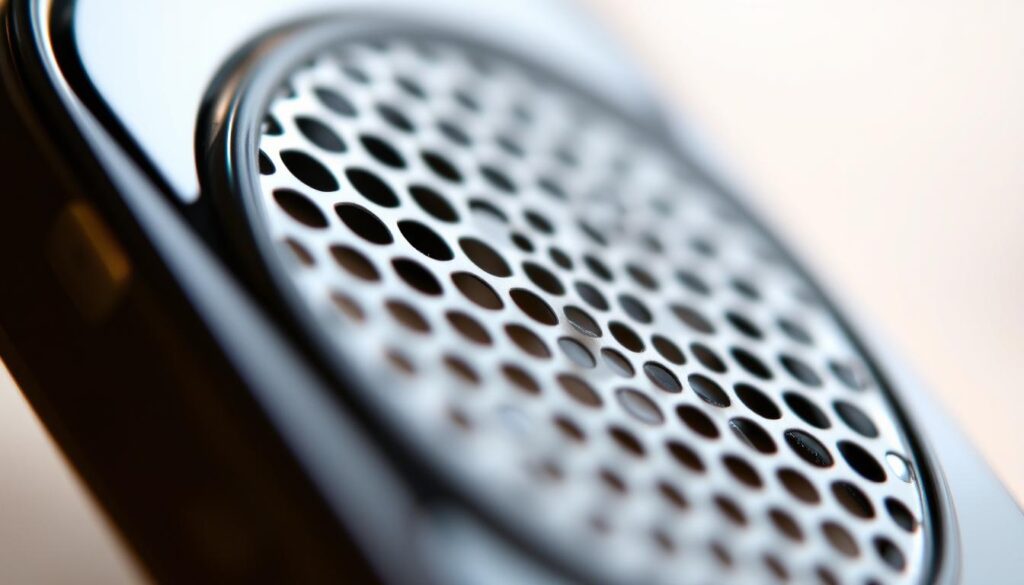
Professional Repair Options
If DIY fixes don’t work, it’s time to get professional help. Water damage can be tricky. If your iPhone is still under warranty or has Apple Care, you might get free or cheaper repairs.
When to Seek Professional Help
Try different ways to fix your iPhone’s speaker first. If none work, it’s time for water damage repair experts. Look for audio problems, speaker failure, or other issues like camera or charging port issues.
If your iPhone isn’t working right or you’re not sure what to do, a pro can help. They can prevent more damage.
Apple Care vs. Third-Party Repair Services
For iphone water damage solutions, you can pick Apple Care or third-party services. Apple Care uses Apple’s own parts and keeps your warranty intact. It’s good for keeping your device in top shape.
Third-party services might be faster and cheaper. But, make sure to choose a trusted service to avoid damage or warranty loss.
Deciding between Apple Care and third-party services depends on your needs and budget. Think about the damage and what you need. This will help you choose the best water damage repair for your iPhone.
Preventing Future Water Damage
The best way to deal with water damage is to prevent it from happening in the first place. As an iPhone user, you can take several proactive steps to safeguard your device against water exposure.
One of the most effective ways to prevent water damage is by using the right accessories. Waterproof cases and covers can significantly reduce the risk of water penetrating your iPhone.
Waterproof Cases and Accessories
Investing in a high-quality, waterproof case is a wise decision for anyone who wants to protect their iPhone from water damage. These cases are designed to create a barrier between your device and water. This allows you to use your iPhone near water without worrying about damage.
Some popular options include:
- Cases with IP68 ratings, which can withstand being submerged in water up to 4 meters deep.
- Waterproof pouches that can be used to protect your iPhone while swimming or engaging in water sports.
- Screen protectors with waterproof coatings to prevent water from seeping into your iPhone’s screen.
| Accessory Type | Water Resistance Level | Price Range |
|---|---|---|
| Waterproof Case | IP68 | $20-$50 |
| Waterproof Pouch | IPX8 | $10-$30 |
| Screen Protector | N/A | $5-$15 |
Behavioral Practices to Adopt
In addition to using the right accessories, adopting certain behavioral practices can also help prevent water damage. Being mindful of your surroundings and taking precautions when near water can significantly reduce the risk of accidental exposure.
Some tips include:
- Avoiding using your iPhone near water sources, such as pools, sinks, or bathtubs.
- Being cautious when using your iPhone in humid environments, such as bathrooms or kitchens.
- Drying your iPhone immediately if it gets wet, using a soft cloth or towel.
Troubleshooting Persistent Speaker Issues
If your iPhone speaker still isn’t working after drying, you need to take more steps. There are ways to fix the problem even if your iPhone was damaged by water.
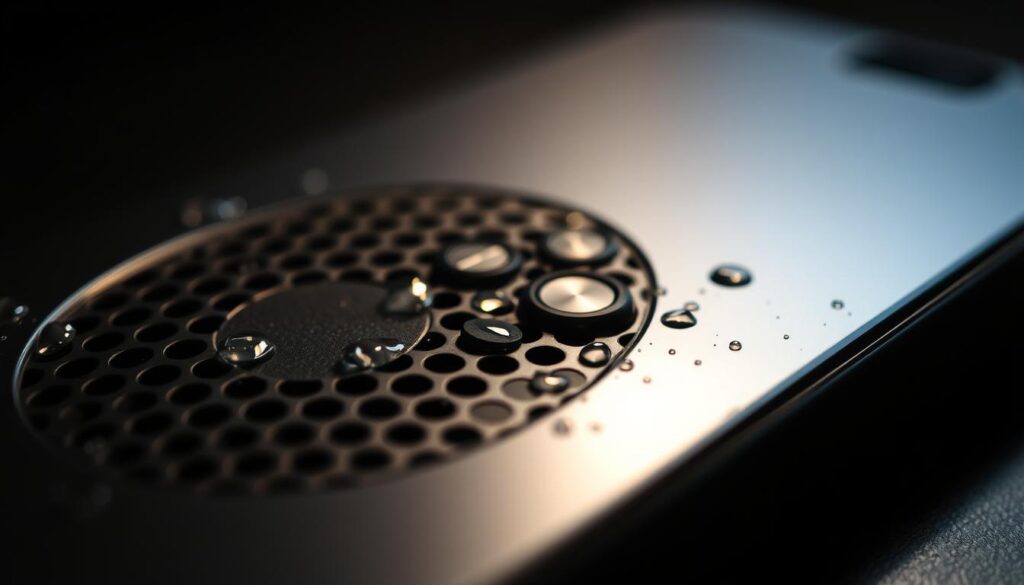
When Water Damage Symptoms Persist
If your iPhone speaker still doesn’t work, it might be more than just water damage. You might need to check if the speaker parts are damaged. Look out for distorted audio, crackling sounds, or if the speaker won’t work at all. Knowing these signs helps you figure out what to do next.
How long your iPhone was in water and how deep it was matters too. The longer it was wet, the worse the damage might be. If it was underwater for a long time, you might need a pro’s help.
Software Solutions to Try
Before fixing hardware, try some software tricks. Restarting your iPhone can often fix the problem. It resets the software.
Also, update your iPhone to the latest iOS. Apple often fixes bugs with updates. Keeping your iPhone updated might solve the issue.
- Check for software updates in Settings.
- Install the latest iOS version if available.
- Restart your iPhone after the update.
Conclusion
Getting water out of your iPhone speaker takes patience and the right steps. This guide shows you how to fix your speaker. It’s key to act fast and use the best methods.
Try sound frequencies, the rice method, or silica gel to dry your iPhone. After, test your speaker. If problems persist, you might need professional help.
To avoid water damage, use waterproof cases and accessories. Also, avoid exposing your iPhone to water. These steps keep your device working well.
Knowing how to fix water damage in your iPhone speaker is crucial. Stay proactive to protect your device. If unsure, seek help from authorized repair services.
FAQ
How do I know if my iPhone speaker has water damage?
Distorted or muffled sound and crackling noises might mean water damage. Look for water droplets in the speaker grill too.
Can I use a hairdryer to dry out my iPhone speaker?
Yes, but carefully. Use low heat and keep the hairdryer away from your iPhone. Follow a drying process step by step.
Are there any apps that can help remove water from my iPhone speaker?
Yes, apps that emit sound frequencies can help remove water. I’ll show you how to use them.
Is the rice method effective in drying out a wet iPhone?
The rice method can work, but do it right. I’ll explain the science and guide you through the steps.
Can I use compressed air to blow out water from my iPhone speaker?
Yes, but be careful. Use compressed air correctly to avoid pushing water further or damaging your iPhone. I’ll tell you how.
How can I prevent future water damage to my iPhone?
Use waterproof cases and accessories. Be careful near water and check your iPhone for vulnerabilities. These habits can protect your device.
What are the signs that I need to seek professional help for my iPhone’s water damage?
If your iPhone still has speaker issues after trying to dry it, seek professional help. I’ll explain when and how to get professional repair.
Can isopropyl alcohol help dry out my iPhone’s speaker?
Isopropyl alcohol can help, but use it carefully. Follow the right steps and take safety precautions to avoid damage.
How do I test my iPhone speaker’s functionality after water removal?
Test your speaker with audio tests after drying it. I’ll help you understand the results and what to do next.
Are there any iPhone model-specific considerations for water damage repair?
Yes, different models have different speaker locations and water resistance. I’ll cover these differences and give model-specific drying tips.
